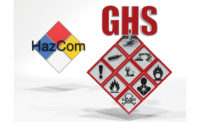Work at height hazards
Serious fall injuries can cost almost $100,000 per case

Working from heights is inherently dangerous. Effective and feasible fall prevention and fall protection measures are readily available. Falls can be prevented and lives can be saved.
Historical data
The U.S. Bureau of Labor Statistics (BLS) data shows that falls to a lower level have been the most frequent type of fatal falls in the workplace, with the majority caused by falls from roofs, followed by ladders, scaffolds, non-moving vehicles, and building girders or other structural steel.
The BLS reported 4,585 fatal work injuries for calendar year 2013, with the category of slips, trips and falls accounting for 724 (16%) of the total. Of these 724 fatalities, 595 were attributed to falls to a lower level. In the cases where the height of fall was known (480 cases), three out of every five were falls of 20 feet or less, with 11% linked to falls from less than six feet. (BLS Census of Fatal Occupational Injuries Summary, 2013)
In addition, the BLS reported that of the 1,162,210 nonfatal occupational injuries and illnesses involving days away from work in 2013, more than 296,000 of those cases were associated with slips, trips and falls. Falls on the same level resulted in 10 median days away from work and falls to a lower level resulted in 20 median days away from work. (BLS Nonfatal Occupational Injuries and Illnesses Requiring Days Away From Work, 2013)
These injuries and fatalities don’t just impact workers, families, co-workers and communities. They also take a great toll on our economy. According to The National Council for Compensation Insurance, these falls result in such serious injuries that the average worker’s compensation for a lost-time claim is close to $100,000 per case. (6/2/2014 Statement by Dr. David Michaels Occupational Safety and Health Administration)
Governing standards
Fall protection is addressed in specific OSHA standards for the construction industry, general industry, shipyard employment, marine terminals and longshoring industry. This article is focusing on general industry and construction industry fall protection standards.
29 Code of Federal Regulations (CFR) Part 1910 – General Industry
The majority of employees in general industry walk or work on level surfaces where slips, trips and falls are common occurrences. These occurrences however are not likely to result in major injuries or fatalities. On the other hand, there are many employees in general industry who climb up and down towers, work in areas where there may be holes in the floor or work on elevated floors which have unprotected sides and edges. These workers often need fall protection. For general industry the trigger height for providing fall protection is four feet.
Current general industry standards recognize the use of physical barriers as the primary methods for employee protection against falls. As of now, the general industry standards do not directly recognize that personal fall protection systems can also provide effective means for employee protection.
The category of work under which the task falls must be determined to properly apply the standards.
American National Standards Institute (ANSI) / American Society of Safety Engineers (ASSE) Z359.1
The ANSI/ASSE Z359.1- “American National Standard Safety Requirements for Personal Fall Arrest Systems, Subsystems and Components” standard was originally published in 1992 and later revised in 1999 (editorial changes only). The purpose of the standard was to address the variety of fall protection equipment being developed and applied to fall arrest equipment used in General Industry and non-construction occupations only.
The original ANSI Z359.1-1992 (R1999) has been expanded and the “new” ANSI Z359 Fall Protection Code was approved in 2007. This Code is an umbrella for a series of 17 fall protection-related standards. Many of the changes incorporated were driven by improper use of equipment by workers at heights. These standards are designed to educate workers concerning proper use of equipment and overall safe work strategies and systems to minimize the distances and consequences of falls from heights should they occur.
29 CFR Part 1926 - Construction
Part 1926 covers construction, which includes alteration, modification, roofing, painting and demolition. For construction the trigger height for providing fall protection is six feet. The construction standards also call out a height of 10 feet specifically for scaffolding and 15 feet for steel erection.
Within the construction industry, the most frequently cited OSHA standard is 29 CFR 1926.501 – Duty to have fall protection. This has been in the top three of OSHA’s Top 10 since 2002 and has held the number one spot since 2011. When we think about this, it should be at the top of employers’ minds. Why? Because working at heights without proper protection is not only very dangerous it is also very easy to spot.
ANSI/ASSE A10.32- 2012 Personal Fall Protection for Use in Construction and Demolition Operations
This standard establishes performance criteria for personal fall protection equipment and systems in construction and demolition and provides guidelines and recommendations for their use and inspection. It includes, but is not limited to fall arrest, restraint, positioning, climbing, descending, rescue, escape and training activities.
OSHA’s three lines of defense
Often, we think of personal protective equipment (PPE) as the primary means to protect employees. Yes, PPE is an important and practical defense against workplace hazards, but OSHA considers PPE the last line of defense. Engineering controls and administrative / work practice controls—methods that are used to eliminate or reduce a hazard—must always be considered first when evaluating and mitigating hazards.
Engineering controls—first line of defense
The first and best strategy is to control hazards at the source. If feasible, the work environment and the job itself should be designed to eliminate the hazards. Work should be done at a single level at grade rather than at multiple levels at elevations. To avoid unnecessary exposure to fall hazards build/assemble on the ground or use tool extensions that allow for the work to be done from the ground.
If the hazard cannot be eliminated, then the hazard should be isolated/enclosed to prevent exposure in normal operations. These are measures that are taken to ensure that workers cannot fall off an unprotected edge. Examples include using guardrails or parapet walls to separate the worker from the fall hazards. Hole covers, handrails and other physical barriers are also means to prevent falls. These are referred to as passive fall restraints.
Administrative/work practice controls—second line of defense
Administrative controls influence the way a task is performed. Work practices include general workplace rules and other operation-specific rules.
There are a number of ways employers can use administrative/work practice controls to protect workers from falls—for example adoption of safe work practices and providing appropriate training. Depending upon the work at hand, these safe work practices may include the use of warning lines, designated areas, controlled access zones, safety monitors and other similar systems to limit the number of workers exposed to the fall hazard.
Personal protective equipment—last line of defense
When exposure to hazards cannot be engineered completely out, isolation and enclosure are not effective, and safe work practices and other forms of administrative controls cannot provide sufficient additional protection, a supplementary method of control is the use of personal protective equipment (PPE) - personal fall arrest systems. When these systems are used, particular attention must be given to identifying attachment points and to ensuring that employees know how to properly use and inspect the equipment.
A personal fall arrest system is designed to safety stop / arrest a fall before the worker strikes a lower level. It has three major components:
• An anchorage / anchor
• A full-body harness
• A connector linking the harness to the anchorage / anchor
Anchors provide a secure point of attachment to an existing structure for the fall arrest system. They can be permanent or temporary and do vary to suit the type of structure available.
Full body harnesses connect the worker to the fall arrest system. They are specifically designed to protect the worker against serious injury in the event of a fall.
Connectors are the critical link. They are the devices that connect the full body harness to the anchorage system.
Conclusion
As the steps in the fall prevention / protection pyramid progress from top to bottom, so does the risk. Eliminating a fall hazard is always preferred.
If the fall hazard cannot be eliminated then the potential exposure to the hazard should be reduced by using passive and or active fall restraints to prevent the fall.
Sometimes we must work at heights and fall preventions systems cannot be used. In these situations, personal fall arrest equipment must be used to minimize the distance and consequence of a fall, should one occur.
Help prevent injuries and save lives by planning ahead to get the job done safely. Provide the right equipment and train everyone to use the equipment safely.
Looking for a reprint of this article?
From high-res PDFs to custom plaques, order your copy today!






